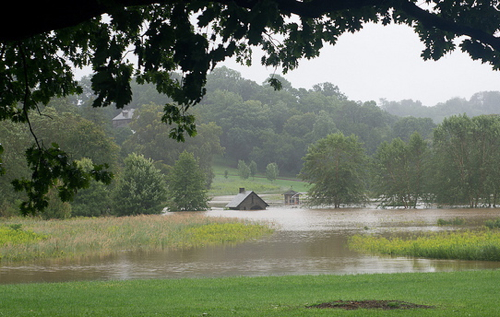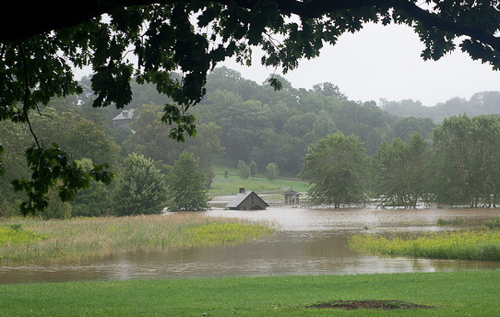 2011 was a record year for liability, with drought in Kansas, Texas, and Oklahoma, and Hurricane Irene taking out crops along the Eastern seaboard. Photo: Bob Gutowski One of the great battles of the 2012 Farm Bill might concern … (drumroll) … crop insurance! Don’t roll your eyes: At $8 billion, it’s the largest part of the current farm bill budget that actually has to do with farms (as opposed to what is literally the largest part, which deals with food stamps). According to a leaked document containing a set of recommendations by the House and Senate Agriculture Committees to the now-defunct supercommittee, the Ag committee’s key priority this time around was to increase federally subsidized crop insurance, even if it meant cutting the direct payments that were so entrenched in earlier bills.
2011 was a record year for liability, with drought in Kansas, Texas, and Oklahoma, and Hurricane Irene taking out crops along the Eastern seaboard. Photo: Bob Gutowski One of the great battles of the 2012 Farm Bill might concern … (drumroll) … crop insurance! Don’t roll your eyes: At $8 billion, it’s the largest part of the current farm bill budget that actually has to do with farms (as opposed to what is literally the largest part, which deals with food stamps). According to a leaked document containing a set of recommendations by the House and Senate Agriculture Committees to the now-defunct supercommittee, the Ag committee’s key priority this time around was to increase federally subsidized crop insurance, even if it meant cutting the direct payments that were so entrenched in earlier bills.
Direct payments are admittedly a lot harder to defend than they were even four years ago. Introduced back when commodity crop prices were rock-bottom enough to crash the economies of several non-subsidized agricultural markets, these payments continued at the same rate, even as grain prices climbed to a record high, cotton became more expensive than it has been at any time since the Civil War, and farmers began actually buying back land that they’d sold to real estate developers.
Just how crop insurance will expand is a critical question. Here’s how federally subsidized crop insurance works now: The feds contract out to a small group of corporations (the same corporations that insure crops across the world), the feds also help farmers pay some or most of the insurance premiums, and they pay out reimbursements when things go south. Meanwhile, the insurance corporation gets money for administering the program, as well as commissions for the policies it sells, and reimbursements for losses.
Federal crop insurance has been around since the 1930s, but it’s grown dramatically in recent years. In fact, participation actually tripled in the last two decades. 2011 was a record year for the industry; $12 billion were paid out in premiums, with the feds subsidizing about 50 percent of the cost of those payments. “We never dreamed in the 1980s of having a program of this size,” Tom Zacharias, president of the trade association National Crop Insurance Services, told the Ag Journal.
As it turned out, 2011 was also a record year for liability, with drought in Kansas, Texas, and Oklahoma, and Hurricane Irene taking out crops along the Eastern seaboard. The record profits made by some farmers were due to others’ record losses. And so the saga known to all who have ever bought insurance kicked into gear — the cost of insurance went up. So did the feds’ contribution.
The insurance industry doesn’t have a great reputation, as a whole, but it does have a record of changing human behavior though financial incentives. In the early days of fire insurance, for instance, insurers refused to cover communities until they built a fire department. In 2006, Lloyds of London wrote a memorable report that strongly advised its members to begin factoring global warming into its calculations [PDF], a move that came off like a warning shot across the bow of a business community that until then had seen environmentalism as a moral rather than a financial issue. “Failure to take climate change into account will put companies at risk from future legal actions from their own shareholders, their investors and clients,” the report read, and went on from there.
Last year’s crop losses weren’t entirely due to climate change — disasters and farming go way back — but they are occurring at a frequency and scale that implies that American farmers now have to work with a new type of weather. According to a report produced by the Congressional Research Service [PDF] in December of last year, government outlays for crop insurance rose from $2.1 billion in 2000 to $3.6 billion in 2006 to $7.3 billion in 2009 — and, over the next 10 years, federal spending on crop insurance is projected to outpace spending on traditional commodity programs by about one-third.
The Farm Bill shapes American agriculture, so it seems irrational to protect farmers trying to maintain their profits on farmland no longer suited for the crops they’re growing. The policy can work to make sure that insurance helps diminish the risks inherent in growing food and trying to sell it to people — but most advocates believe this should happen in a way that applies to everyone, not just a few individual farmers.
When it looked like the Farm Bill might still be passed by the supercommittee, farmers who grow commodities like corn, soy, and cotton were “going for the maximum of what they could possibly dream of,” says Ferd Hoefner, Policy Director for the National Sustainable Agriculture Coalition. Farm lobbies raised the amounts they would get for each crop lost “to unimagined levels” in the form of what has been called shallow loss coverage.
Now that the bill will be considered by the entirety of Congress, Hoefner adds, crop insurance will “most likely get seriously revisited.”
“We’re entering unknown territory,” says Julia Olmstead, of the next phase of the Farm Bill process. Olmstead helped write a report on global warming and the Farm Bill for the Intsitute for Agriculture and Trade Policy (IATP). “Creating a federal crop insurance system, with no limits on federal outlays, without simultaneously giving farmers the tools to adapt to the effects of climate change is incredibly irresponsible from both a food security and fiscal perspective,” she said. “It’s like offering a home owner a fire insurance policy, but not even requiring the most basic preventative measures, such as smoke alarms or fire extinguishers.”
Olmstead’s report advised an insurance policy that encourages farmers to plant multiple crops; a farm that grows a diversity of crops is less vulnerable to disasters (two programs in the farm bill, AGR and AGR-lite, already encourage these practices, and they could be expanded). The report also advises the expansion of programs like the Conservation Stewardship Program, which incentivizes farmers to protect the water, soil, and air. (It’s been so popular that only 57 percent of eligible farmers have been funded. With the proposed cuts in the supercommittee report, that percentage would go down to 46 percent.)
In other words: Expect a lot of wrassling over the issue of insurance over the next few months. As the cash cow in the Farm Bill, it will also be the star to which hopes and dreams are pinned.
“We never get what we want,” says Olmstead, who envisions a Farm Bill that would give more support to sustainable farming and less to agriculture that requires heavy inputs of fuel, fertilizer, and cash. “If 2008 was about new programs, this one is about holding on to what we can. And I think we’ve made a lot of progress.”




